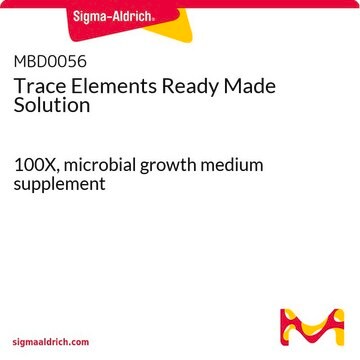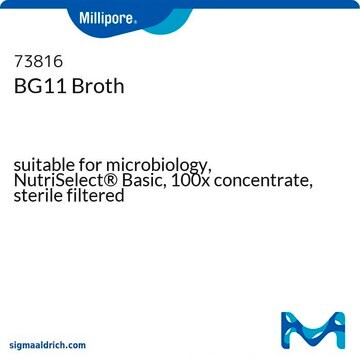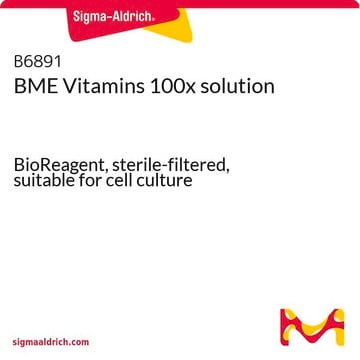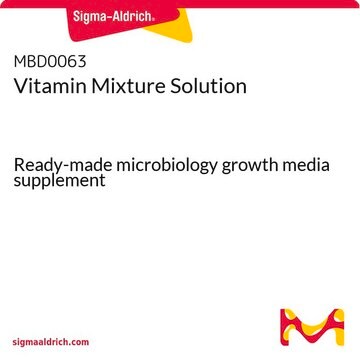92949
Trace Metal Mix A5 with Co
suitable for microbiology, Sterile supplement recommended for the culture and maintenance of Cyanobacteria
Synonym(s):
Trace Elements solution
Sign Into View Organizational & Contract Pricing
Select a Size
All Photos(1)
Select a Size
Change View
About This Item
UNSPSC Code:
41171614
NACRES:
NA.85
Recommended Products
Quality Level
sterility
sterile (Filtered and Aseptic Handled)
form
liquid
shelf life
limited shelf life, expiry date on the label
application(s)
environmental
life science and biopharma
microbiology
storage temp.
2-8°C
suitability
cyanobacteria
General description
Trace Metal Mix A5 with Co is a supplement supplying trace elements for the growth of blue green algae and act as a fertilizer. Cyanobacteria have relatively high metal requirements for optimal growth compared to other bacteria largely due to metal cofactors in the oxygenic photosynthetic electron transfer apparatus, such as cytochromes, plastocyanin and chlorophyll rings. An adequate supply of trace metals is required to maintain optimal growth, particularly as these higher metal requirements make Cyanobacteria more prone to trace nutrient limitation. Co acts as a determinant of marine cyanobacteria distribution and productivity.
Application
Trace Metal Mix A5 with Co is a supplement added to BG11-Broth (Blue Green Medium) (Cat. No. 73816), recommended for the culturing and maintenance of Cyanobacteria
Components
Composition per liter:
H3BO3 2860 mg
MnCl2 · 4H2O 1810 mg
ZnSO4 · 7H2O 222 mg
Na2MoO4 · 2H2O 390 mg
CuSO4 · 5H2O 79 mg
Co(NO3)2·6H2O 49 mg
add 1 mL to 1000 mL BG11 Broth (Cat. No.73816)
H3BO3 2860 mg
MnCl2 · 4H2O 1810 mg
ZnSO4 · 7H2O 222 mg
Na2MoO4 · 2H2O 390 mg
CuSO4 · 5H2O 79 mg
Co(NO3)2·6H2O 49 mg
add 1 mL to 1000 mL BG11 Broth (Cat. No.73816)
related product
Product No.
Description
Pricing
Storage Class
12 - Non Combustible Liquids
wgk_germany
WGK 1
flash_point_f
Not applicable
flash_point_c
Not applicable
Choose from one of the most recent versions:
Already Own This Product?
Find documentation for the products that you have recently purchased in the Document Library.
Jared Church et al.
Bioresource technology, 243, 147-153 (2017-06-27)
Microalgae can offer several benefits for wastewater treatment with their ability to produce large amounts of lipids for biofuel production and the high economic value of harvested biomass for biogas and fertilizer. This study found that salt concentration (∼45gL
Michaela Groma et al.
mBio, 11(4) (2020-08-28)
Staphylococcus aureus is a common cause of bacteremia that can lead to severe complications once the bacteria exit the bloodstream and establish infection in secondary organs. Despite its clinical relevance, little is known about the bacterial factors facilitating the development
Eleni Koutra et al.
Bioresource technology, 294, 122232-122232 (2019-10-15)
Digested effluents are usually deprived of the appropriate levels of organic carbon or macro- and micro-nutrients to effectively sustain microalgal growth. In this regard, Parachlorella kessleri was cultivated in an agro-waste digestate supplemented with different glucose concentrations, magnesium and trace
Diversion and phylogenetic relatedness of filterable bacteria from Norwegian tap and bottled waters.
Colin Charnock et al.
Journal of water and health, 17(2), 295-307 (2019-04-04)
Numerous articles have documented the existence of filterable bacteria. Where filtration is the chosen method of sterilization for medicinal or media components, these bacteria will by definition render products non-sterile. They may further represent a health hazard to the end
Matthew E Mead et al.
Genome biology and evolution, 12(7), 1119-1130 (2020-05-23)
Gene regulatory networks (GRNs) drive developmental and cellular differentiation, and variation in their architectures gives rise to morphological diversity. Pioneering studies in Aspergillus fungi, coupled with subsequent work in other filamentous fungi, have shown that the GRN governed by the
Our team of scientists has experience in all areas of research including Life Science, Material Science, Chemical Synthesis, Chromatography, Analytical and many others.
Contact Technical Service








